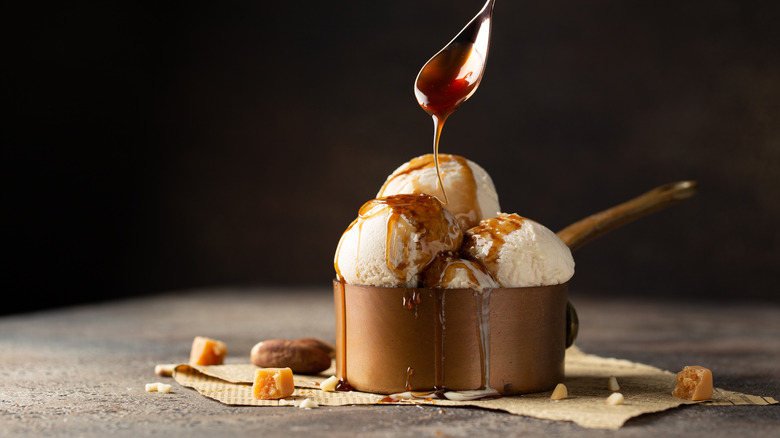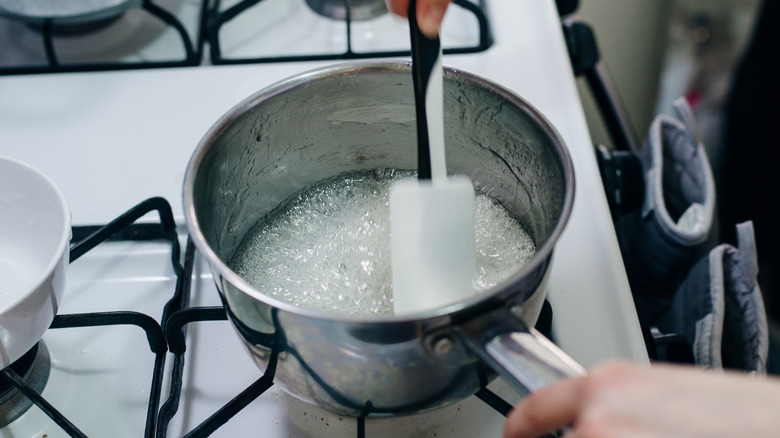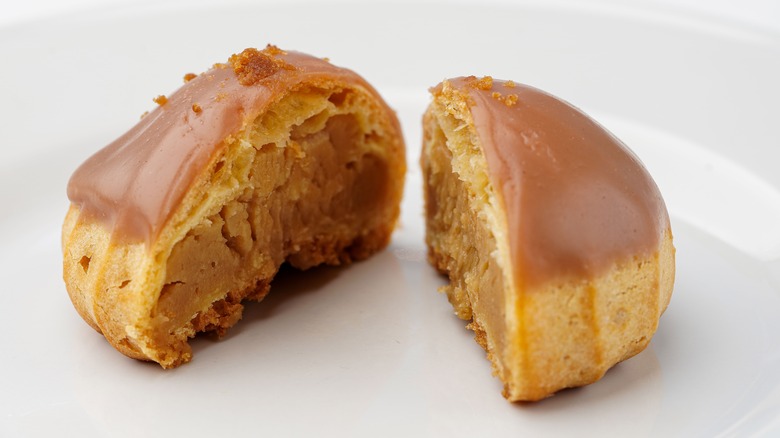The Difference Between Making Wet And Dry Caramel Sauce Is One Simple Step
Making caramel sauce can often be an intimidating prospect for even the most experienced home cooks. From the fear of burning it, and watching your perfectly golden liquid turn acrid and charred in a split-second, to the potential crystallization of the sugar leaving you with a grainy, lumpy mess, working with molten sugar isn't exactly the most beginner-friendly of techniques. To prevent these mishaps when preparing a decadent caramel sauce, Food Republic spoke to Adriano Zumbo is a world renowned pastry chef, and runs the acclaimed Zumbo Pâtisserie on Australia's sunshine coast.
The expert introduced a concept known as "wet" caramel, wherein the sugar you would normally just melt in a dry pan (when making what's technically called "dry" caramel) becoming incorporated in water before any heat is applied. It's a basic change, but one that can make a world of difference if you're a budding pâtissier. "If just adding water to your caramel, the main purpose is [that it acts] as a carrying agent and allows the sugar crystals to dissolve faster," Zumbo told Food Republic. "The process itself cooks for longer, evaporating out around 90% of the liquid, giving you more time (just a little) and control over your final caramel." This caramel-making method might actually be ideal for beginners who need that extra leeway when trying not to burn the temperamental confection.
What to watch out for when making wet caramel
Wet caramel's gradual cooking process allows for easier monitoring and provides a set of sticky, sweet training wheels, if you will. However, there is one potentially significant pitfall that's worth watching out for. "Crystallization ... is one of the biggest risk factors in a wet caramel [other than] burning," Adriano Zumbo warned us. This is where the sugar within the mixture literally forms clumps of crystals, leading to your once smooth liquid caramel becoming grainy — and potentially causing the entire mixture to seize up.
Thankfully, there are a few ways around it. Some are technique-based, such as waiting for the sugar to fully cook without stirring it, or using a damp pastry brush to ensure that the sides of the pan you're using stay clean and free of crystals — but one that Zumbo suggests is even easier. "In most recipes for wet caramel there will be a portion of glucose or corn syrup added to aid in the prevention of crystallization," he explained. The corn syrup is what's known as an interfering agent, preventing the chemical chains that lead to crystallization from forming at all (an acid like lemon juice would also serve the same purpose). So, adding a little corn syrup to a the wet mixture is an easy way to ensure a foolproof caramel, if you're learning the basics.
The process of making a dry caramel
Making a dry caramel, meanwhile, is a slightly more hands-on process, as the shorter time you have means it takes a little more concentration to avoid burning or seizing. It is, however, a significantly simpler method, in the sense that all dry caramel requires is sugar and patience. The only thing you really need to worry about is having a steady enough control over the temperature of your stove. "The biggest risk is [caramelizing too] fast[,] which can lead to burning or inconsistent [flavors] if the heat is not controlled properly," explained Adriano Zumbo. Once you've burned the caramel, it's impossible to bring it back to life — and you'll have to start from scratch.
If you can keep your temperature under control, you'll have a brilliantly versatile ingredient on your hands — perhaps more easily fit into various different recipes than its wet counterpart. Because dry caramel has no additional liquid contents, you can adapt its recipe into pretty much any context. Our expert suggested various uses such as "a deglaze for a caramel Chantilly cream, [an added] caramel base flavor to your ice cream recipe[,] or a key note for a caramel milk chocolate ganache." Though it may be more technically difficult to achieve, dry caramel is an ideal option for broadening your pastry-making horizons, if you can master it.
Which type of caramel should you choose?
When it comes to picking which style of caramel you want to use in your homemade dessert recipes, it's important to figure out what the requirements are for the dish you're making. For the more practiced at home pâtissier, dry caramel might be a better option. "[If you're] a super confident cook[,] then dry caramel is a lot faster and more agile," Adriano Zumbo explained. Plus, once you've made it, you can repurpose any leftovers into a handy sweet seasoning. The expert instructed, "You can even make dry caramel ahead [of time,] and once cool[,] blend it into a powder and keep [it] airtight in a container or vac-sealed bag[.]" What you are left with is a ready-made ingredient that you can sprinkle to all your favorite sweet treats for an extra amplified caramel flavor.
If you are looking to enjoy the confection on its own, however, wet caramel may be the way to go. This liquid-based method creates a caramel that is more structurally sound, and is ideal for dipping and frosting. According to Zumbo, wet caramel is a good option when you are "making a silky caramel sauce, sugar decorations, or soft and chewy caramel confections." Ultimately, both styles of caramel taste remarkably similar, if not identical, once prepared — so, the option you choose is ultimately up to your personal preference, and the amount of confidence where tricky cook times are concerned.




